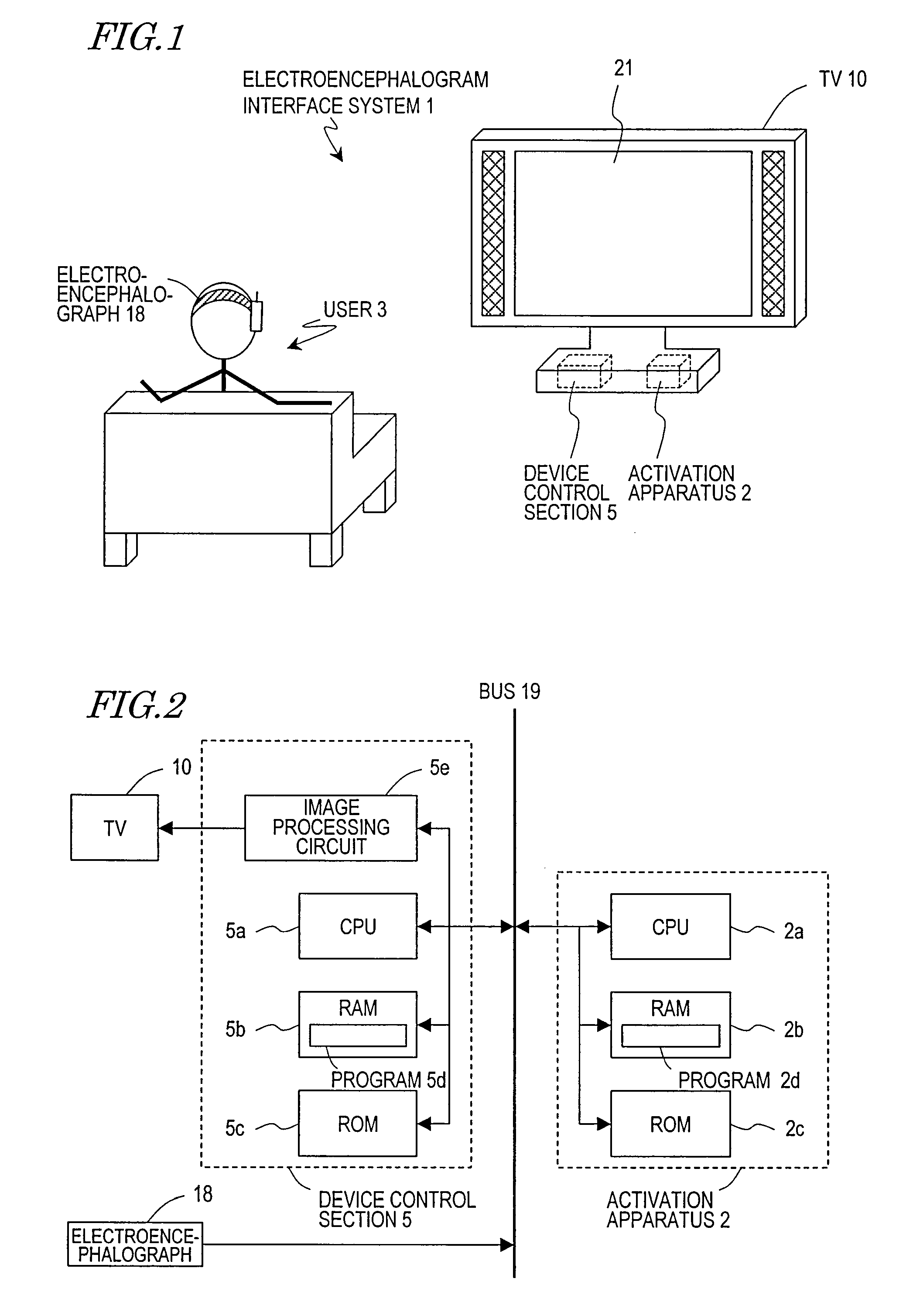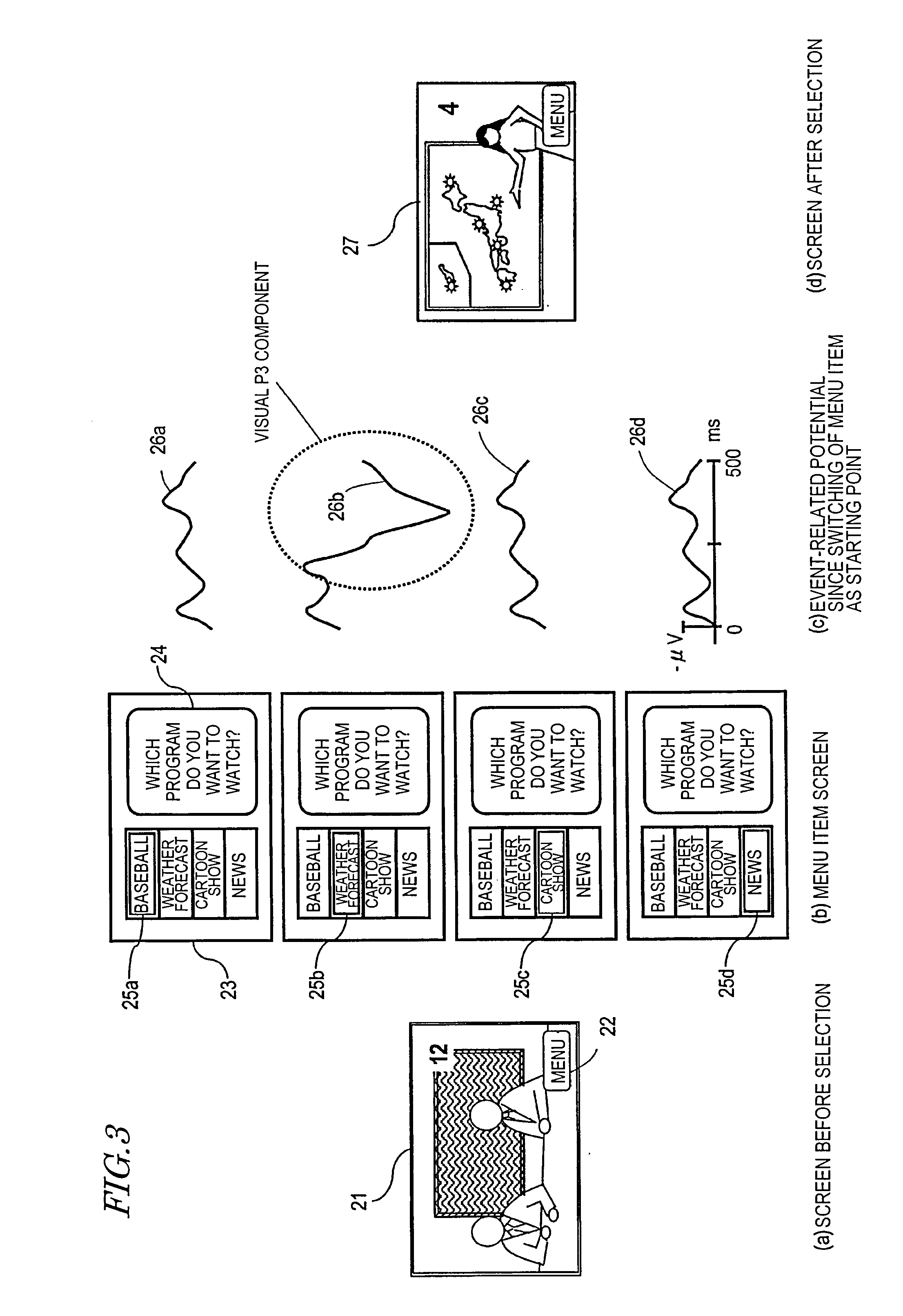Electroencephalogram interface system and activation apparatus
a technology applied in the field of encoding and encoding electrodes, can solve problems such as the inability to execute a manipulation with both hands
- Summary
- Abstract
- Description
- Claims
- Application Information
AI Technical Summary
Benefits of technology
Problems solved by technology
Method used
Image
Examples
embodiment 1
[0066]Hereinafter, an electroencephalogram interface system according to the present embodiment will be first described, followed by a description of the construction and operation of an activation apparatus for activating an electroencephalogram interface.
[0067]FIG. 1 shows a construction and an environment of use for the electroencephalogram interface system 1 of the present embodiment. The electroencephalogram interface system 1 is exemplified so as to correspond to the system construction of Embodiment 1 described later.
[0068]The electroencephalogram interface system 1 is used for providing an interface for manipulating a TV 10 by utilizing an electroencephalogram signal from the user 3. An electroencephalogram signal from the user 3 is acquired by an electroencephalograph 18 which is worn on the head of the user 3, and transmitted to a device control section 5 in a wireless or wired manner. The device control section 5 internalized in the TV 10 recognizes an intent of the user ...
embodiment 2
[0120]In Embodiment 1, the flicker frequency of one menu activation icon (or LED) is fixed, and is utilized for the determination as to whether or not to execute an electroencephalogram interface function.
[0121]In the present embodiment and the next embodiment, electroencephalogram interface systems will be described in which the flicker frequency of the menu activation icon is variable, and the flicker frequency is controlled so as to adapt to various situations. Since there is one menu activation icon, there is no need to consider relationships with the flickering of other icons or the like as in Non-Patent Document 2. Moreover, since the icon is allowed to flicker on the TV screen through video signal processing, it is possible, by changing the processing, to change the flicker frequency.
[0122]Note that, in the aforementioned Non-Patent Document 2, a multitude of LEDs having different flicker frequencies are arranged, a frequency which appears in the electroencephalogram signal o...
embodiment 3
[0150]In Embodiment 2, changes in the electroencephalograms are detected by utilizing the fact that changes in a content which is currently presented or a person's state affects the visual evoked potential, and the flicker frequency of a menu activation icon is changed based on the changes in the electroencephalograms.
[0151]In the present embodiment, changes in a content which is currently presented are detected by analyzing the content, and the flicker frequency of a menu activation icon is changed by utilizing this result.
[0152]FIG. 13 shows the functional block construction of the electroencephalogram interface system 11 including the activation apparatus 12 of the present embodiment. In FIG. 13, component elements having the same functions as those of the electroencephalogram interface system 101 in FIG. 10 are denoted by like reference numerals, and the descriptions thereof are omitted.
[0153]In the electroencephalogram interface system 11, an output signal of a content to be pr...
PUM
 Login to View More
Login to View More Abstract
Description
Claims
Application Information
 Login to View More
Login to View More - R&D
- Intellectual Property
- Life Sciences
- Materials
- Tech Scout
- Unparalleled Data Quality
- Higher Quality Content
- 60% Fewer Hallucinations
Browse by: Latest US Patents, China's latest patents, Technical Efficacy Thesaurus, Application Domain, Technology Topic, Popular Technical Reports.
© 2025 PatSnap. All rights reserved.Legal|Privacy policy|Modern Slavery Act Transparency Statement|Sitemap|About US| Contact US: help@patsnap.com



